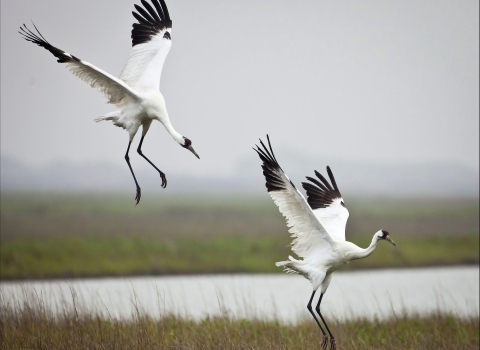LAKEWOOD, Colo. – One of the most elusive rodents along Colorado’s Front Range is getting a boost on the road to recovery.
The Preble’s Meadow Jumping Mouse (Preble’s mouse), which lives along vegetated streams from El Paso County, Colorado to southern Wyoming, was designated a threatened species under the Endangered Species Act in 1998. With its large hind legs and long tail, this mouse can jump many times its own body length when alarmed, but spends most of its time scurrying about through grass and other vegetation within or near the 100 year flood plain.
In its 1998 finding, the U.S. Fish and Wildlife Service (Service) determined that the Preble’s mouse was likely to face extinction in the foreseeable future because of the loss of habitat from urban development and other disturbances. Now, a draft recovery plan has been developed to restore the mouse’s populations and keep it from disappearing along the Front Range of Colorado and Wyoming.
The Preble’s mouse is a little member of a big rodent family that is broadly distributed across the United States. But this Rocky Mountain subspecies lives in some of the most valuable real estate in one of the fastest-growing areas of the country. As a result, it’s been squeezed by the extensive loss and degradation of its habitat from housing developments, water and flood control projects, agriculture and other human uses.
The draft recovery plan, which is being released for public review, was developed with Colorado’s and Wyoming’s state wildlife agencies, The Nature Conservancy, Colorado Natural Heritage Program, ERO Resources, U.S. Forest Service, and Ecology and Environment. The recovery plan describes actions necessary for the Preble’s mouse’s recovery, establishes criteria for delisting the species, and estimates the time and cost for implementing the needed recovery actions.
Under the plan, the Preble’s mouse can be considered for delisting when researchers can demonstrate that two large populations numbering around 2,500 individuals and five medium wild populations, numbering between 500-2,500 individuals each are established across the recovery area. Alternatively, the mouse can be proposed for delisting if experts determine that there is an increasing population trend spanning a 20-year period. Local management teams will identify areas of sufficient acreage and connectivity to support populations of this size.
With the release of the draft recovery plan, the Service will open a 60-day public comment period until June 10, 2016. All relevant information received from the public, government agencies, the scientific community, industry, and other interested parties will be considered and addressed prior to approval of a final recovery plan.
Recovery of endangered or threatened species is the primary goal of the Service’s endangered species program. To help guide recovery efforts, the Service prepares recovery plans for federally-listed species that describe actions necessary for the conservation of the species and establish objective, measurable recovery criteria. When met, these criteria would result in a determination that the species no longer needs the protection of the ESA.
The mission of the U.S. Fish and Wildlife Service is working with others to conserve, protect, and enhance fish, wildlife, plants, and their habitats for the continuing benefit of the American people. For more information on our work and the people who make it happen in the West, connect with us through any of these social media channels: Facebook, Twitter, Flickr, YouTube, and Instagram.


